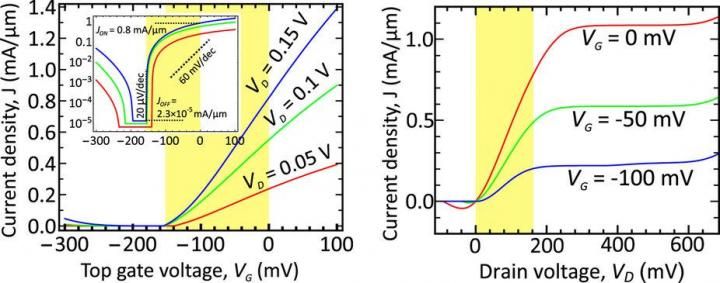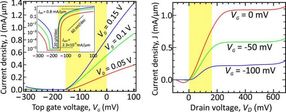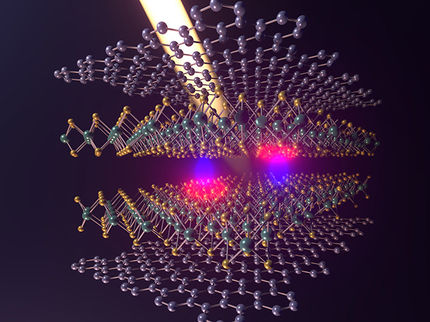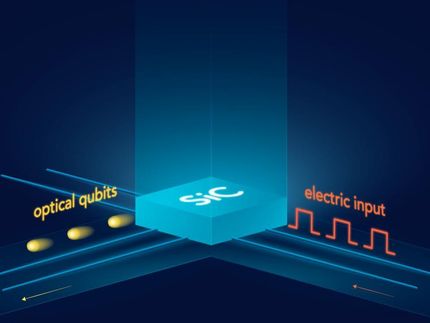New type of graphene-based transistor will increase the clock speed of processors
Advertisement
Scientists have developed a new type of graphene-based transistor and using modelling they have demonstrated that it has ultralow power consumption compared with other similar transistor devices. The most important effect of reducing power consumption is that it enables the clock speed of processors to be increased. According to calculations, the increase could be as high as two orders of magnitude.

(A) Electron spectrum E(p) in bilayer graphene (left) and energy dependence of its density of states, DoS (right). At energy levels corresponding to the edge of the "Mexican hat" the DoS tends to infinity. (B) The red areas show the states of electrons that participate in tunneling in bilayer graphene (left) and in a conventional semiconductor with "ordinary" parabolic bands (right). Electrons that are capable of tunneling at low voltages are found in the ring in graphene, but in the semiconductor they are only found at the single point. The dotted lines indicate the tunneling transitions. The red lines indicate the trajectories of the tunneling electrons in the valence band.
Dmitry Svintsov et al.

The shaded area of 150 mV is the operating voltage range of the transistor, which is much narrower than the operating range of conventional silicon transistors (500mV). The subthreshold swing (slope of the characteristic) of the proposed transistor is also significantly higher than the limiting slope that can potentially be gained from MOSFETs (metal-oxide-semiconductor field-effect transistors). This limiting slope is shown as a dotted line on the inset image.
Dmitry Svintsov et al.


"The point is not so much about saving electricity - we have plenty of electrical energy. At a lower power, electronic components heat up less, and that means that they are able to operate at a higher clock speed - not one gigahertz, but ten for example, or even one hundred," says the corresponding author of the study, the head of MIPT's Laboratory of Optoelectronics and Two-Dimensional Materials, Dmitry Svintsov.
Building transistors that are capable of switching at low voltages (less than 0.5 volts) is one of the greatest challenges of modern electronics. Tunnel transistors are the most promising candidates to solve this problem. Unlike in conventional transistors, where electrons "jump" through the energy barrier, in tunnel transistors the electrons "filter" through the barrier due to the quantum tunneling effect. However, in most semiconductors the tunneling current is very small and this prevents transistors that are based on these materials from being used in real circuits.
The authors of the article, scientists from the Moscow Institute of Physics and Technology (MIPT), the Institute of Physics and Technology RAS, and Tohoku University (Japan), proposed a new design for a tunnel transistor based on bilayer graphene, and using modelling, they proved that this material is an ideal platform for low-voltage electronics.
Graphene, which was created by MIPT alumni Sir Andre Geim and Sir Konstantin Novoselov, is a sheet of carbon that is one atom thick. As it has only two dimensions, the properties of graphene, including its electronic properties, are radically different to three-dimensional carbon - graphite.
"Bilayer graphene is two sheets of graphene that are attached to one another with ordinary covalent bonds. It is as easy to make as monolayer graphene, but due to the unique structure of its electronic bands, it is a highly promising material for low-voltage tunneling switches," says Svintsov.
Bands of bilayer graphene, i.e. the allowed energy levels of an electron at a given value of momentum, are in the shape of a "Mexican hat" (fig. 1A, compare this to the bands of most semiconductors which form a parabolic shape). It turns out that the density of electrons that can occupy spaces close to the edges of the "Mexican hat" tends to infinity - this is called a van Hove singularity. With the application of even a very small voltage to the gate of a transistor, a huge number of electrons at the edges of the "Mexican hat" begin to tunnel at the same time. This causes a sharp change in current from the application of a small voltage, and this low voltage is the reason for the record low power consumption.
In their paper, the researchers point out that until recently, van Hove singularity was barely noticeable in bilayer graphene - the edges of the "Mexican hat" were indistinct due to the low quality of the samples. Modern graphene samples on hexagonal boron nitride (hBN) substrates are of much better quality, and pronounced van Hove singularities have been experimentally confirmed in the samples using scanning probe microscopy and infrared absorption spectroscopy.
An important feature of the proposed transistor is the use of "electrical doping" (the field effect) to create a tunneling p-n junction. The complex process of chemical doping, which is required when building transistors on three-dimensional semiconductors, is not needed (and can even be damaging) for bilayer graphene. In electrical doping, additional electrons (or holes) occur in graphene due to the attraction towards closely positioned doping gates.
Under optimum conditions, a graphene transistor can change the current in a circuit ten thousand times with a gate voltage swing of only 150 millivolts.
"This means that the transistor requires less energy for switching, chips will require less energy, less heat will be generated, less powerful cooling systems will be needed, and clock speeds can be increased without the worry that the excess heat will destroy the chip," says Svintsov.
Original publication
Other news from the department science
Most read news
More news from our other portals
See the theme worlds for related content
Topic World Spectroscopy
Investigation with spectroscopy gives us unique insights into the composition and structure of materials. From UV-Vis spectroscopy to infrared and Raman spectroscopy to fluorescence and atomic absorption spectroscopy, spectroscopy offers us a wide range of analytical techniques to precisely characterize substances. Immerse yourself in the fascinating world of spectroscopy!

Topic World Spectroscopy
Investigation with spectroscopy gives us unique insights into the composition and structure of materials. From UV-Vis spectroscopy to infrared and Raman spectroscopy to fluorescence and atomic absorption spectroscopy, spectroscopy offers us a wide range of analytical techniques to precisely characterize substances. Immerse yourself in the fascinating world of spectroscopy!


































































